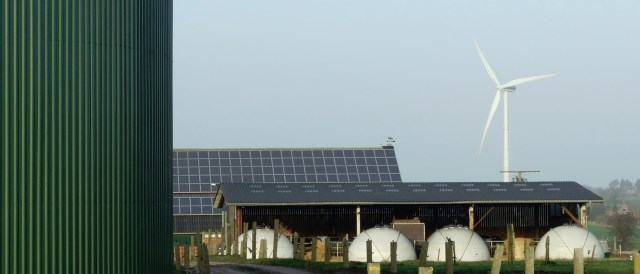The Berlin-based think tank for the Energiewende has published its own proposal for revisions to the Renewable Energy Act, which specifies feed-in tariffs. The renewables community is up in arms. Craig Morris explains.

If Agora’s proposals were implemented, installation of two of the three renewable technologies in this photo would probably stop. (Photo by Florian Gerlach, CC BY-SA 3.0)
When you begin discussing the energy transition solely in terms of cost, in a way you have already lost the debate. Up to now, the focus has been on unlimited grid access and a fair return for the numerous small businesses, communities, and citizens investing in renewables. Is it possible to protect energy democracy and focus on cost?
Judging from the numerous responses to Agora’s proposal in the blog world and social media, apparently not. Many experienced campaigners for community ownership, such as Eurosolar, immediately came out against the idea. The press release was just published in English, but the full study is only available in German at least until next week (PDF).
Agora basically proposes a new market design for 2014-2017, with a goal of 40 percent renewable power by 2020 (the government’s actual goal is only 35 percent). Here, one could immediately complain that, once again, we are focusing too heavily on the power sector, though prices for domestic heat are expected to increase by up to 18 percent this winter – compared to only a few percent for electricity next year, if at all. Strangely, however, I seem to be the only person criticizing Agora for this narrow focus.
Everyone else is homing in on the proposal to limit feed-in tariffs to a maximum of 8.9 cents per kilowatt-hour. This price would allow onshore wind to continue to be built (theoretically, but see below), while offshore wind, biomass, and PV could come to a screeching halt. For instance, the current feed-in tariffs for PV arrays installed in October (the rates are currently reduced each month by 1.8 percent) go from 9.88 to 14.27 cents.
Proponents of solar therefore charge that the end is nigh if Agora gets its way, and the situation is precarious for biomass as well. Starting in January, biogas units larger than 750 kilowatts have to switch completely to “direct marketing,” a kind of hybrid payment system with a lower fixed payment and a fluctuating return from sales on the power exchange. But as with photovoltaics, feed-in tariffs for power from biomass increase as the systems get smaller – rising even above the highest rates for new PV. On the other hand, Agora proposes that a capacity bonus be paid for biomass units, which are dispatchable.
All other bonuses would be done away with, and “direct marketing” would be required for all new systems – regardless of technology – starting at a system size of a megawatt. Essentially, practically all new wind turbines would be subject to “direct marketing”; last year, the average turbine size was slightly above 2.4 megawatts.
There are other parts of the proposal that everyone will applaud, such as an increase in the reduced renewables surcharge for energy-intensive industry because, as Agora correctly points out, “these firms already benefit from roughly 1 cent lower wholesale prices.” And those exemptions would be limited to firms that actually face international competition.
Agora calls its proposal “radically simplified.” The renewables community seems to agree it is radical because it might spell an end to the citizen-driven movement. I’m not so sure myself, but it’s hard to calculate. My problem is not so much with the word “radical,” but with the label “simplified.” The press release says, for instance, that the capacity bonus would be “maximum of €500 per kilowatt per year up to a maximum of 100 megawatts” – so if I want to calculate the return on my investment in a biomass unit, I now have my work cut out for me. And to think that the original Feed-in Act of 1991 started off as a two-page document.
Craig Morris (@PPchef) is the lead author of German Energy Transition. He directs Petite Planète and writes every workday for Renewables International.
Hallo Craig,
wir, das Klimaschutz-Netz, haben den Energieblogger-Feed auf unserer Facebook-Seite eingebunden, d.h. auch deine Beiträge erscheinen dort.
Das ist auch in Ordnung, solange nicht zu viele Beiträge auf einmal in englischer Sprache erscheinen, denn wir sind eigentlich eine deutschsprachige Seite.
Da du in letzter Zeit sehr viele Beiträge auf einmal in auf die Energieblogger-Seite stellst, dominieren diese aber unsere FB-Seite, was bereits zu Beschwerden geführt hat.
Vielleicht kannst du ja etwas weniger, dafür häufiger posten.
Für englische Texte haben wir extra eine weitere FB-Seite gegründet. Noch besser wäre es daher, wenn man den englischsprachigen Feed, vom deutschsprachigen Energieblogger-Feed, abtrennen würde, dann könnten wir ihn auf unsere englischsprachige Seite leiten.
Es ist einfach so, wenn die Beschwerden über die englischsprachigen Beiträge bei uns zunehmen, dann könnte es sein, dass wir den ganzen Energieblogger-Feed nicht mehr veröffentlichen.
Mit freundlichen Grüßen
Udo
[…] Nejdříve přehled německých výkupních tarifů(FIT-Feed-in-tariffs) pro elektřinu z větru a fotovoltaiky pro rok 2014 spolu s odhady do budoucna. Ovšem, jsou to odhady, jsou založené na oficiálních publikacích, jako je tento PDF. “Agora” hodnoty jsou na základě studie, kterou jsem komentoval zde. […]